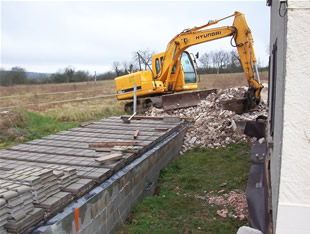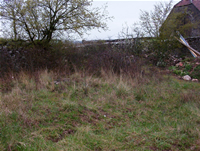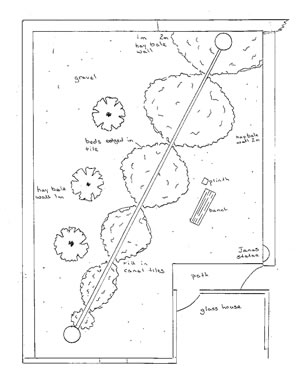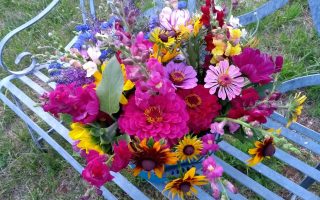The Celtic Herbalist – April Update

Works In progress
Preparatory Works
As we did not dig too close to the house foundations, we have a gap between the cistern and the house. We have filled this gap with rubble and will smooth it over. Then we will pour concrete over it and the cistern to create the south-facing terrace.
Below you can see the digger shifting hard-core into the gap – a delicate operation so close to the house.
Garden number 1: The Gaul’s Potager
This is a garden of vegetables, fruit, flowers and herbs arranged in a geometric pattern: three large vegetable beds with four rough circles around them. These comprise: a pool, a fruit mound, a salads’ wheel and a grain circle.
In the centre is a fire pit with a quatrefoil of culinary herbs around it. The pit represents the fire often found in the middle of a Celtic village.
The fruit mound will be jealously guarded by the Spirit of the Fruit (a Celtic style manikin) on its summit.
Garden number 2: Rhiwallon’s Garden
This is a memorial garden of tincture beds. It is in memory of Rhiwallon of Myddfai the physician who, in the 13th century, collected the remaining two-thousand year old Celtic remedies in the oral tradition still extant, at that time, in Britain.
The garden comprises nine rectangular beds of medicinal herbs arranged in the medieval fashion with the requisite water feature (here, with pestle and mortar) overflowing into the stone basin.
A Celtic cross, recording Rhiwallon’s life is under the peach tree and a Celtic style bench is being made for under the fig tree.
Garden number 3: Llyn-y-Van-Vach
.jpg)
Digger forming the pool
This garden is a “Celtic Reflection Garden”.
This is to be a formal rectangular pool with a large Cauldron of Keridwen emptying into the pool for oxygenation. This will be backed by two large fastigiate yews and surrounded by old, hand-cut stones.
The Four Medicine Gardens.
(These gardens are “Celtic Reflection Gardens”)
“Medicine Garden” of the Month: The Garden of Ease

Site of the Garden of Ease
This garden will be bounded on the north side by a greenhouse and on the other sides by walls of rendered straw-bale. The trees around the central water-feature will be small-leafed lime. The water-feature itself, standing at the heart of the Celtic cross, is a jug on a plinth pouring out water onto a hexagonal bed of stone slabs interspersed with Irises planted in pebbles. The beds of tranquilising herbs lie beneath the limes.
a) The Garden of Sleep
This garden is a garden of sedatives and hypnotics. It uses the classic spiral pattern of the late Bronze and Iron Ages and has a loggia around some of it.
b) The Garden of Flow

Designer’s plan of the Garden of Flow
This garden is in the shape of the staff of Aesculapius. It contains alterative herbs to assist systems’ flows e.g. Cleavers for lymph flow.
c) The Garden of Ease
This Garden is in the shape of the Celtic Cross. It contains mild tranquillising herbs such as Chamomile and Lemon Balm.
d) The Garden of Restoration
This garden contains Trophorestoratives (such as the Tonics and Bitters) and Neurorestoratives e.g. Oats.
Planned gardens
Below is a list of the gardens planned for the immediate future:
5) The Ancestors’ Ground – This is a Thyme garden of monoliths. Thyme was the herb of death.
6) The Druid’s Pavement – This is a Limestone Pavement with small mounds and pools. It will be plantd with examples of the indigenous and rare bulbiferous flora e.g. Martagon lillies.
7) The Barrow Field – This contains burial mounds, each to be planted in an individual way. It is bisected by a meandering path.
8) The Ceremonial Orchard – This is a pergola of espalliered pome and stone fruit trees. It leads down to the sacred grove.
9) The Sanctuary – This is built in the style of a ‘Celtic sanctuary’, or sacred place and will contain the ambulatory surrounded by its own henge and trees.
10) The Winds of Life – This is a complex star-shaped pergola garden planted to Aromatics. It contains a Celtic wind god.
What are Celtic Reflection Gardens?
A Celtic Reflection Garden can have any form and our designer will adapt the central principles to the specific constraints and requirements of the site. A few common factors are requisite, however. A Celtic Reflection Garden is bounded
to provide privacy. The boundary could be a stone wall, or a few wattle hurdles. It has a gate, or door guarded by a Janus figure. A water source, for you and for other lives in the garden, is a central feature. A Yew tree is a ‘must’. The rest is up to you: veggies, herbs, flowers …?
A Celtic Reflection Garden, by encouraging relaxation and reflection, will enhance your health and happiness. It will bring back the sense of the sacred to you, the life in your garden, and all life on Earth.
What are Celtic Water Tableaux?
As the gardens develop, we will install water tableaux (statues, installations and plants). Celtic in character and made by local artesans, they will have their own water source generated using renewable energy (mostly solar). They are not complete gardens, but will create focal points in our Celtic Landscape. The following is a list of tableaux that we will have.
- Warrior’s Tribute
- Cry the Coronach
- Sacred Grove
- Seer’s Chair
- Pool of The Meddygon
- Snake Stone
- Spring Shrine
Share to: Facebook Twitter LinkedIn Email
More in centre, garden, health, villages
Leave a reply
Your email address will not be published. Required fields are marked *



